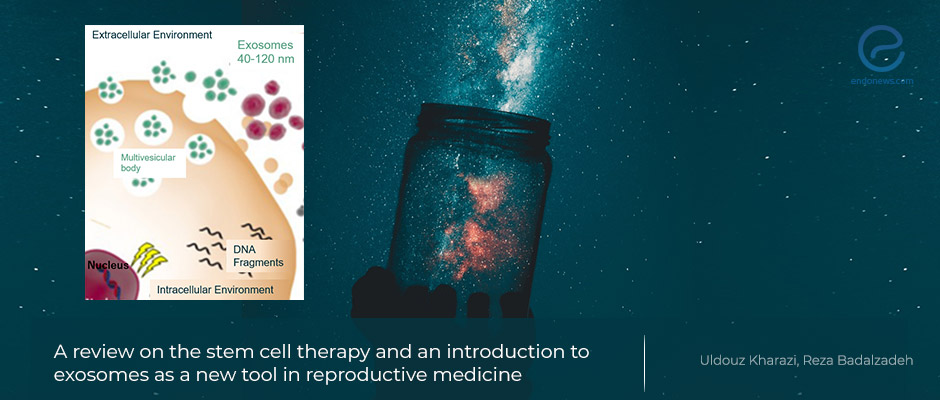Stem cell and exosome therapy
Oct 6, 2020
Stem cell therapy and an introduction to exosomes: A new tool in reproductive medicine
Key Points
Highlight:
- Dr. Badalzadeh group emphasizes the importance of stem cells and exosomes and suggests the use of the combination of stem cells and exosomes in reproductive medicine.
Background:
- Stem cell therapy has shown promising effects in regenerative medicine including myocardial infarction, nervous system impairment, retinal damage, and liver diseases.
- Exosomes are bi-layer nano-vesicle cargos, released from the naturally occurring late endosomes and contain different molecules such as enzymes, microRNAs, DNA fragments, lipids, and proteins.
- Exosomes seem to have therapeutic effects, and the combination of exosome therapy with tissue engineering techniques has become a novel approach in the field of regenerative medicine.
Key points:
- Stem cells may have an important effect on fertility;
- They can differentiate into germ cell lineage and gamete-like structures.
- Stem cells can decrease ovarian inflammation in the presence of autoimmune diseases, bone-marrow-derived stem cells can increase estrogen.
- Stem cells also may have important actions on male infertility.
- Exosomes have roles in sperm-egg fusion:
- They exist in semen; regulates calcium signaling, and are critical in sperm activity-motility.
- The oocyte-derived exosomes also play a role in the acrosome reaction.
- Exosomes have a role in embryonic development:
- The embryonic growth and development are affected by microvesicles/exosomes released from different components of the placenta such as trophoblast, luminal and granular endometrium.
- Possible exosomes therapy for endometriosis;
- Administration of retinal astroglial cell-derived, mesenchymal stem cell-derived, or cardio myocyte-derived exosomes could be effective in endometriosis.
- These treatments will reduce angiogenesis through the migration of the endothelial cells and the generation of vessel tubes.
Conclusions:
- Compared to stem cells, the use of exosomes has several advantages; they do not induce inflammation or do not cause teratoma formation.
- Furthermore, they deliver their cargo to the cell of interest, enter the cell, and interact with cellular organelles.
- Based on previous studies, the administration of a combination of exosomes for alleviating the symptoms of many diseases including endometriosis.
Lay Summary
These days, two experimental methods, stem cell, and exosome therapy are getting more attention. Stem cell therapy has shown promising effects in regenerative medicine, including myocardial infarction, nervous system impairment, retinal damage, and liver diseases.
Recent studies showed that stem cells could secrete nano-scale vesicles called exosomes. Exosomes are soluble, bi-layer nano-vesicle cargos, ranging from 30 to 150 nanometers. They are released from the naturally occurring late endosomes and contain different molecules such as enzymes, microRNAs, DNA fragments, lipids, and proteins. Exosomes affect cell proliferation, migration, angiogenesis, gene expression, immune response, and induce embryo implantation. As some of the exosomes seem to have therapeutic effects, the combination of exosome therapy with tissue engineering techniques has become a novel approach in the field of regenerative medicine.
In this article, Dr. Badalzadeh group emphasizes the importance of stem cells and exosomes and suggests the use of the combination of stem cells and exosomes in reproductive medicine. This paper was recently published in the journal “Reproductive Biology”.
The potential stem cell effects on female and male fertility, the role of exosomes in sperm-egg fusion, and the role of exosomes in embryonic development are summarized in detail.
Most interesting for the reader of the EndoNews page, the exosomes therapy may be designed for endometriosis. For example, administration of a combination of exosomes such as retinal astroglial cell-derived exosomes, mesenchymal stem cell-derived exosomes, and cardio myocyte-derived exosomes could be an effective tool in endometriosis patient by reducing angiogenesis.
The authors concluded that applying exosomes to living tissues is more feasible and less threatening in comparison to stem cell therapy. Compared to stem cells, the use of exosomes has several advantages; they do not cause teratoma formation and immunological reactions. Furthermore, they deliver their cargo to the cell of interest. Based on previous studies, the administration of a combination of exosomes for alleviating the symptoms of many diseases including endometriosis.
Research Source: https://pubmed.ncbi.nlm.nih.gov/32900639/
Infertility Stem cell Exosome Reproductive medicine

